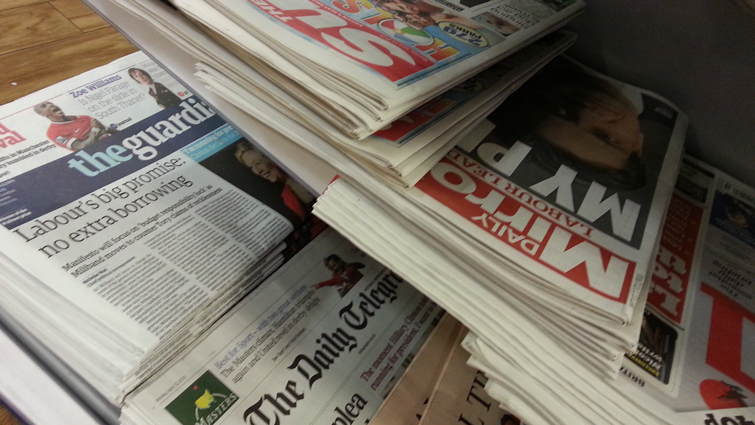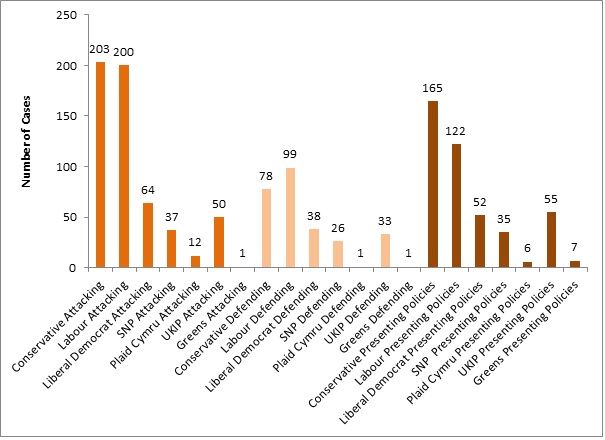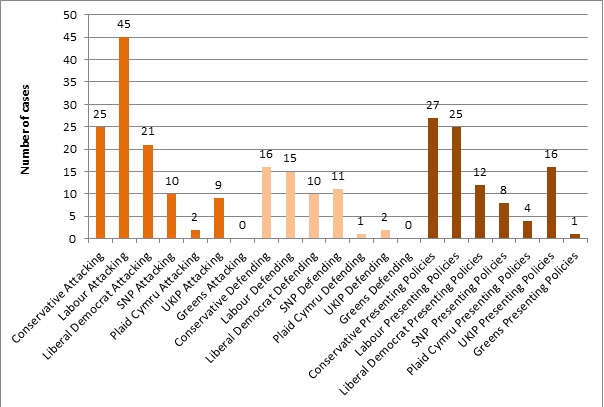Media coverage of 2015 General Election (Report 1)
 General Election 2015: The Media Campaign
General Election 2015: The Media Campaign
Report 1 (covering 30th March-8th April inclusive)
Introduction
This is the first of a series of weekly reports by the Loughborough University Communication Research Centre on national news reporting of the 2015 UK General Election. See our blog for more details about this project (https://blog.lboro.ac.uk/general-election/.)
The results in this report are derived from detailed content analysis of election coverage produced on the weekdays (i.e. Monday to Friday inclusive) between 30th March and 8 April from the following news outlets:
Television: Channel 4 News (7pm), Channel 5 News (6.30pm), BBC1 News at 10, ITV1 News at 10, BBC2 Newsnight, Sky News 8-8.30pm
Press: The Guardian, Independent, Times, Daily Telegraph, Daily Mail, Daily Express, Mirror, Sun, Star and Metro
We analysed all election news found in the entire duration of all television programmes. For the press, we included election news found on the front page, the first two pages of the domestic news section, the first two pages of any specialist election section and the page containing and facing the papers’ leader editorials.
Key findings
Our analysis is organised under three sections:
- ‘Stopwatch’ examines the amount of coverage during the sample period, asking which party’s representatives have been quoted the most?
- ‘Quotation time’ for the two main parties has been virtually the same
- the press have been more likely to quote Conservatives
- Liberal Democrat representatives are well behind the two main parties
- UKIP representatives are almost level with the Liberal Democrats in press but trail in television coverage
- the Scottish Nationalists are in fifth place and Nicola Sturgeon is the sixth placed individual in terms of media appearances. According to the media Sturgeon was the outstanding performer in the Leaders’ Debate.
- Greens coverage is derisory and Natalie Bennett is trailing in 20th place in terms of media appearances by an individual, way behind any of his rivals in the Leaders’ Debate and also Samantha Cameron who at 9th is the second most prominent woman after Nicola Sturgeon
- Coverage of the ‘challenger’ parties- UKIP, SNP, Greens and Plaid Cymru- is ‘presidential’, i.e. dominated by their respective leaders
- ‘Direction’ examines the extent to which parties are presented and explores whether this a negative campaign?
- The major two parties have been more aggressive in attacking their rivals, with Labour more likely to dwell on defending themselves as well as presenting their own policies.
- Labour’s television coverage has been more likely to feature them attacking opponents than explaining their own policies
- The Conservatives’ press coverage has been more likely to feature the attacking opponents than explaining their own policies
- ‘Issues’ examines which topics attracted most media attention during the opening stage of the formal campaign.
- The economy and taxation have been the major issues covered by the media in the opening stages of the election campaign
- Europe and employment have been significant themes courtesy of the debates over the proposed ‘in/out referendum’ and ‘zero hours contracts’ respectively
- Major issues of public concern (as measured by polls) such as immigration, health and education, have been comparatively neglected by the media
- Uncertainty surrounding the outcome of the election has meant there has been a large amount of coverage about the democratic process itself e.g. the polls, party strategies, etc.
1. Stopwatch
Press reporting of the opening period of the General Election reveals a substantial difference in the coverage of the rival contenders. The Conservatives have had the greatest amount of attention devoted to both the party and its leader. The Tories lead Labour by a considerable margin in terms of the amount their representatives’ words have been directly quoted by the print media (see Figure 1.1). It is interesting to speculate whether this reflects a bias to the incumbents’ ability to shape the news narrative or a more obvious partisan allegiance on the part of a centre-right leaning press.
This difference in the press reporting is in marked contrast to the broadcasters’ coverage where the two major parties have enjoyed broadly the same levels of exposure in terms of direct quotation time on air. There was only an 82 second difference between the Conservatives and Labour- no mean feat given their combined total is 5840 seconds (see Figure 1.2). Despite relaxations of the rules governing balanced exposure in broadcast coverage of elections these figures suggest old habits die hard, at least in terms of the parity of treatment given the main two parties.
Neither of David Cameron or Ed Miliband is the overwhelmingly dominant representative of their parties in terms of broadcast time. Cameron does, however, emerge as more prominent in newspaper coverage, accounting for just under half of all quotes attributed to the Conservatives. The equivalent for Miliband is approximately a quarter.
The other parties have received considerably less media attention than Labour or the Conservatives. Whereas Liberal Democrat representatives have been slightly quoted more times on TV than their UKIP counterparts, the reverse is the case with the newspaper coverage. But perhaps what is more striking is how leader focused the coverage is of these parties together with the Scottish Nationalists, who trail in as the fifth placed party according to the same measures (see 1.1 and 1.2). Nicola Sturgeon’s utterances dominate both broadcast and print media in terms of quotes attributed to the SNP. This is also the case, to a lesser extent, with Nigel Farage and UKIP. This ‘presidential’ focus can also be detected in newspaper space and air time devoted to quoting Plaid Cymru and the Greens but is important to note that both parties overall showings have been negligible.
Figure 1.3 Media appearances by individuals
Figure 1.3 provides a more detailed picture of the prominence of different politicians during the early stages of the 2015 campaign. Cameron and Miliband dominate, but Nick Clegg has to share third place with Nigel Farage. George Osborne is next in fifth with Ed Balls at seventh reflecting the significance of the economic debate during the opening exchanges of the campaign (see ‘issues’ below). Nicola Sturgeon appears in sixth position following her appearance in the Leaders’ Debate and Tony Blair eight following his intervention over the Conservatives’ proposed European referendum. Plaid Cymru’s Leanne Wood, another participant in the Debate, benefits from the media exposure appears in tenth place. Wood’s position further highlights the comparatively low ranking of Natalie Bennett, the only other leader to appear in the televised encounter, who only just makes the top twenty. The final place in a top ten Bennett would have aspired to be in is taken by ninth placed Prime Minister’s wife Samantha Cameron following her appearance alongside her husband during the campaign so far. Interestingly the only woman in the list to feature higher than Mrs Cameron is Ms Sturgeon.
Figure 1.4: Media evaluations of party leaders’ performances in the Debate
Nicola Sturgeon’s prominence is, as has been noted, partly in response to her performance in the Leaders’ Debate. Her victory, and the scale of it, is not clear from the rival polls published after the encounter not to mention the various contending claims made rival politicians in the so-called ‘spin room’ after the programme aired. But what is clear from our analysis of the response to the debate is that Sturgeon was by far the winner if judged by the media evaluation of her and her rivals’ performances (see Figure 1. 4). No other contender came close.
2. Direction
How negative is the campaign?
Mudslinging is an established part of election campaigning, with political parties of all colours spending as much time attacking their opponents and their policies than promoting their own policies, but how negative is this campaign? Further, if campaigning is negative which party was most effective at slinging mud? Which party spent the most time attacking their rivals and least defending?
Our analysis examined the extent to which party sources in news coverage attacked their opponents, defended themselves from attacks or presented their policies. If negative campaigning is rife we would expect to find a high incidence of parties attacking their rivals and defending themselves and less promoting their policies.
Figure 2.1: Overall stance of politicians towards their opponents in all media coverage
The graph shows the main political parties in the opening stage of the campaign are clearly running a more negative than positive campaign, attacking and defending more than promoting their policies. Those Labour and Conservative politicians that appeared in the news mainly attacked their opponents and defended themselves and promoted their policies to a lesser extent.
While the other parties still attacked their opponents the gap between attacking/defending and presenting their own policies was much smaller. Indeed, Green candidates spent more time presenting their own policies than attacking their rivals. But this has to be contextualised against their very low media profile (see above).
Was there any difference between coverage in the broadcasters and the press? One might expect Conservative supporting newspapers to give less room to Labour attacks than Conservative attacks, and vice versa for Labour papers compared to the broadcasters who are regulated.
Figure 2.2: Overall stance of politicians towards their opponents in television coverage
Figure 2.3: Overall stance of politicians towards their opponents in press coverage
The table above shows on television news at least Labour was much more negative than their nearest rivals attacking their opponents and policies almost twice as much as presenting their own policies. Indeed, the Conservatives appearances were more positive promoting their policies more often than attacking their opponents. Plaid Cymru, Green and UKIP candidates presented their own policies and defended themselves more frequently than attacking their opponents.
The table shows a different picture in press coverage. Here the Conservatives were more negative than Labour, attacking more often, and Labour candidates were more defensive, perhaps not surprising given the dominance of the Tory supporting press in the sample. For the SNP, the Greens and UKIP the division between attacking, defending and promoting was fairly evenly balanced.
In sum, the main two parties attacked more than they defended. The minor parties attacked each other parties but were more likely to appear promoting their policies and defending themselves.
3. Issues
The most prominent substantive issues covered during the first 10 days of the formal campaign related to the ‘economy’ and ‘taxation’. Party disagreements on the proliferation of ‘zero hour’ contracts and the implications of any post-election ‘in-out’ referendum over EU membership pushed ‘Employment’ and ‘Europe’ up the media agenda for at least part of the sample period. Debates about the ‘NHS’ and ‘Immigration/ minorities/ religion’, subjects that have ignited media coverage of past campaigns, have yet to command any significant prominence.
Table 3.1: Most prominent themes (all media)
| Percent of themes | ||
|---|---|---|
| 1 | Election Conduct/Citizen Engagement/Parties | 40.6% |
| 2 | Economy | 10.3% |
| 3 | Taxation | 7.9% |
| 4 | Employment | 5.9% |
| 5 | Europe | 5.5% |
| 6 | Business | 4.7% |
| 7 | NHS | 4.6% |
| 8 | Immigration/Minorities/Religion | 4.3% |
| 9 | Constitutional Issues | 3.5% |
| 10 | Social Security | 2.5% |
| 11 | Standards/Corruption/Scandals/Sleaze | 2.4% |
| 12 | Women | 1.3% |
| 13 | Education | 1.2% |
| 14 | Defence/Military | 1.1% |
| 15 | Media | 1.0% |
| 16 | Health | .7% |
| 17 | Environment | .5% |
| 18 | Transport | .4% |
| 19 | Foreign Policy | .3% |
| = | Housing | .3% |
| = | Higher/Further Education | .3% |
| 22 | Farming/Agriculture | .2% |
| 23 | Information Technology | .1% |
| = | Arts/Culture/Sport | .1% |
| = | Crime/Law and Order | .1% |
| = | Public Services | .1% |
Notes: up to three themes could be coded per election news item
The marginalisation of these and other issues reveals a striking disparity between the news agenda and public concerns. Recent polling by IPSOS Mori asked respondents to identify the ‘most important issues facing Britain’. The top 5 issues were ‘Immigration/ immigrants’ (45% of mentions); ‘NHS’ (38%), ‘Economy’ (28%), ‘Unemployment’ (21%) and ‘Education/ Schools’ (20%). Most of these topics languished fairly low down the media pecking order in the early days of the campaign.
As in previous election campaigns, a very high proportion of coverage was focused upon the electoral process itself (party strategies, dirty tricks, opinion polls, news management, etc.). Interest in these issues has been heightened by the closeness and uncertainty of the contest, in which speculation about potential coalitions and their durability has been added to journalists’ perennial fascination with establishing who’s on the up, and who’s going to win.
Background
This research is funded by a grant from the British Academy/ Leverhulme Trust
The Loughborough Communication Research Centre (LCRC), based at the Department of Social Sciences, Loughborough University, has substantial experience of conducting media content audits. It has worked closely with a range of funding bodies, charities and the public sector organisations including: the BBC Trust, Ofcom, The Guardian and the Electoral Commission.
Since 1992, it has conducted an analysis of news coverage of the British general election campaign.
The LCRC draws on the experience of its members who are leading international media and political analysts who have published widely in the fields of communication research and methodology. The LCRC has no links with any political parties or interest groups, nor has it conducted research or consultancy on behalf of organisations that could be categorised in these terms. See https://blog.lboro.ac.uk/general-election/.
Inter-coder reliability
Ensuring reliability between coders is an essential aspect of any project involving content analysis and especially in large scale projects such as this. For the results of any content analysis to be deemed reliable there needs to be a high level of agreement between two or more coders when coding the same news item. This research ensures such levels of reliability are achieved through a number of measures. 1, using post-doctoral researchers and doctoral students working in the LCRC whose research concerns the media; 2, providing rigorous coder training prior to the analysis; 3, conducting a close monitoring of coders during the campaign; and 4, conducting reliability tests and addressing any areas of weakness these expose.






